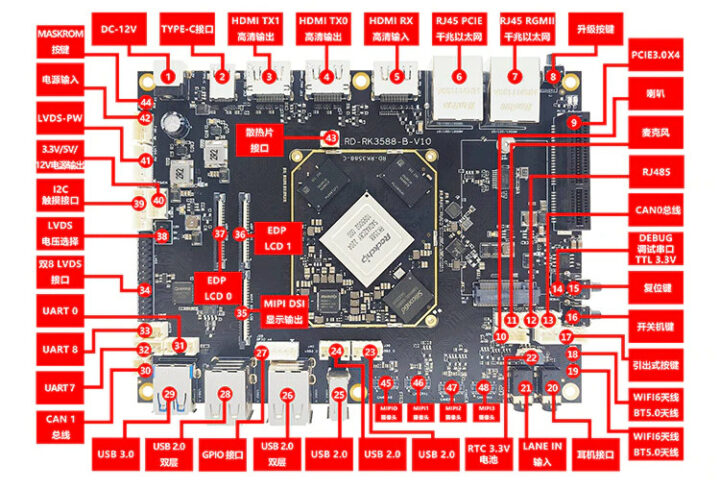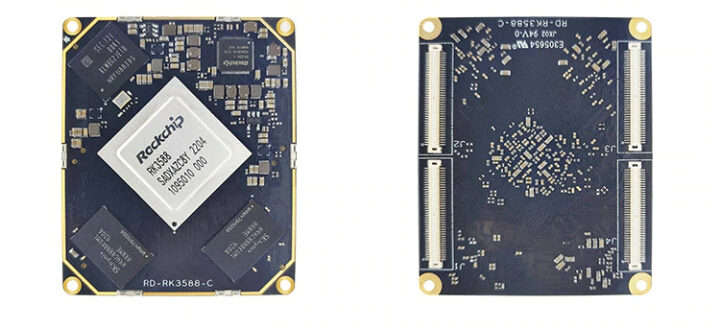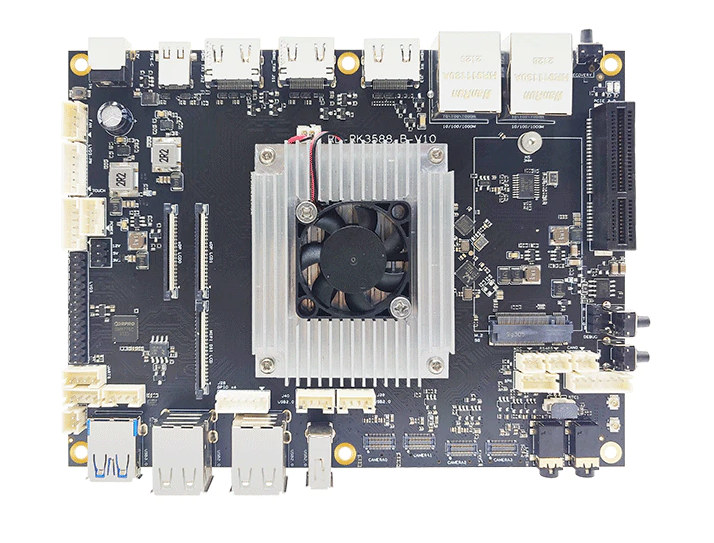We’ve already seen several Rockchip RK3588 modules with Firefly Core-3588J, Turing RK1, and Banana Pi RK3588_CV1, all with an edge connector to insertion into the carrier board. Rongpin RD-RK3588 system-on-module is a little different with four board-to-board connectors that enable a slightly more compact design, and should expose more I/Os than say a 314-pin MXM edge connector.
The module ships with up to 16GB of RAM, 128 GB of storage, a Rockchip RK806-1 PMIC, and the company also offers a development kit with RD-RK3588-B baseboard fitted with the module for evaluation and early software development.
RD-RK3588 board-to-board module
RD-RK3588-C core module specifications:
- SoC – Rockchip RK3588 octa-core processor with 4x Arm Cortex-A76 cores @ up to 2.4 GHz, 4x Arm Cortex-A55 cores, Arm Mali-G610 MP4 GPU with support for OpenGL ES3.2, OpenCL 2.2, Vulkan1.1, 6 TOPS NPU, 48MP ISP, 8Kp60 video decoding, 8Kp30 video encoding
- System Memory – 4GB, 8GB, or 16GB LPDDR4x
- Storage – 32GB, 64GB, or 128GB eMMC 5.1 flash
- Carrier board interface – 4x high-density board-to-board connectors (CNXSoft: I’m guessing 80-pin or 100-pin each, the photos are not clear enough)
- Storage – Up to 3x SATA 3.0, 1x SD card
- SDIO – 1x SDIO for WiFI, 1x SDIO for SD card
- Display I/F
- 2x HDMI output up to 4Kp60 (CNXSoft: Not sure why not 8Kp60)
- 2-ch 4-lane eDP up to 1080p60
- DisplayPort up to 4K
- 2-lane MIPI DSI supports up to 2K
- Camera – 6x MIPI CAMERA CSI inputs
- Audio – 3x I2S (2x 8-channel, 1x 2-channel)
- Networking – 2x Gigabit Ethernet
- USB
- 3x USB 2.0, including one OTG
- 2x USB 3.0 shared with DP
- PCIe – 1x PCIe 3.0 x4, 3x PCIe 2.0 x1
- Serial – 10x UART, 2x CAN bus
- Low-speed I/Os – 5x SPI, 7x I2C, 15x PWM
- ADC – 4x ADC inputs
- GPIO – Up to 120x GPIOs
- PMIC – Rockchip RK806-1
- Power Supply – 3.4 to 5.5V (5A+ recommended)
- Dimensions – 60 x 50 x 4.2mm
- Temperature Range – -10°C to +60°C
- Life (MTBF?) – “Continuous operating life is more than 5 years”
The company lists Android 12, Ubuntu 18.04, Linux 5.10 + QT 5.15, and Debian11 operating systems for the module, but I was unable to find any public documentation and download links.
RD-RK3588 development board
- Supported SoM – RD-RK3588-C described previously, and shown with heatsink and fan in the photo above
- Storage – MicroSD card socket
- Video Outputs
- 2x HDMI outputs up to 4K (multiplexed with eDP)
- 2-channel eDP connector (multiplex with HDMI)
- Dual-channel LVDS up to 1920×180
- 1x 2-lane MIPI DSI connector
- Video Inputs
- 1x HDMI input up to 1080p60
- 6-channel MIPI CSI camera input
- Audio – 3.5mm headphone/speaker jack, 3.5mm Line-In jack, header for dual speaker (3W/8 Ohms)
- Networking
- 2x Gigabit Ethernet RJ45 ports
- Wi-Fi 6 and Bluetooth 5.0 via Ampak AP6275 module
- Support for 5G modules (Quectel and Zhanrui) with two SIM card slots on the baseboard (at the back).
- USB
- 1x USB 3.0 port
- 5x USB 2.0 Type-A host ports, 1x USB Type-C port, 2x USB 2.0 interfaces on header
- Serial – 4x serial ports via headers, 2x CAN bus via headers, 1x RS485
- I/O headers – 1x I2C, 4x GPIO
- Expansion – PCIe 3.0 x4 socket
- Misc – RTC + battery
- Power Supply – 12V/2A via DC jack
- Dimensions – 155 x 107 mm
 Somehow, they did not think SATA connectors would be a nice thing to have. Again, there’s no documentation whatsoever, so you’d have to contact the company for details.
Somehow, they did not think SATA connectors would be a nice thing to have. Again, there’s no documentation whatsoever, so you’d have to contact the company for details.
The RD-RK3588 CPU module and development board are sold on Aliexpress for respectively $235.57 and $349.78 with 4GB RAM and 32GB eMMC flash. Scrolling down on the Aliexpress page, we can also see some accessories with RM500Q 5G modem, and a range of 5-inch to 15.6-inch displays.
Thanks to theguyuk for the tip.

Jean-Luc started CNX Software in 2010 as a part-time endeavor, before quitting his job as a software engineering manager, and starting to write daily news, and reviews full time later in 2011.
Support CNX Software! Donate via cryptocurrencies, become a Patron on Patreon, or purchase goods on Amazon or Aliexpress. We also use affiliate links in articles to earn commissions if you make a purchase after clicking on those links.






They have a A311D2 in the works https://m.alibaba.com/product/1600522306009/AMLOGIC-A311D2-Development-Board-A311D2-Core.html?
Interesting to see variations on the SOC theme, which adds to uer choice.
The AMLogic sector for S922X and above is likely to be decimated at this rate.
Do you base that on the Fab that makes Rockchip SoC putting up prices by 20% and more, or just a hate of Amlogic ?
I like AMLogic and use 3 boxes based upon their SOC’s.
It is indisputable that the RK3588 is a giant leap above anything that AMLogic is currently producing and from quite a few demos shown, is also, out of the box, working quite well.
Inflation has recently driven up the prices of just about everything across the globe, so this is the norm right now for millions of products and services.
And if you do want to compare pricing, take the Vim4 at $199+ and then look t the pending RK3588 equivalent types of boards like the Rock5B and it is easy to see where the real value lies, not to mention price in relation to performance power.
I would love to see the AML S908X but there is no sign of it right now, so logically, in this area of the market, I think that AMLogic and it’s board vendors are going to find their financial lives affected quite badly and very soon.
> Vim4 at $199+
The Vim4 is a 220 bucks piece (the ‘early bird discount’ expires in less than 2 weeks). And since no sustained performance possible w/o the $20 fansink, in reality it’s a $240+ product (for whatever reasons a lot of buyers forgetting shipping and taxes).
BTW: wrt the next Amlogic thing thejerryuk (Amlogic stockholder based on ‘quality’ of comments) will most probably link to this.
I see you are back to beer o’clock days. Are you still promoting Orange Pi ? After all you was paid by Orange Pi to write their software. Software that went on to be some of the most hated anti user software on the internet. It was the same time you was telling people to buy Orange Pi boards, but not declaring you worked for the Orange Pi company.
Is it just me, or is this the first SoM that exposes all RK3588 I/O?
they will send baidu link to download software and document after the product ordered